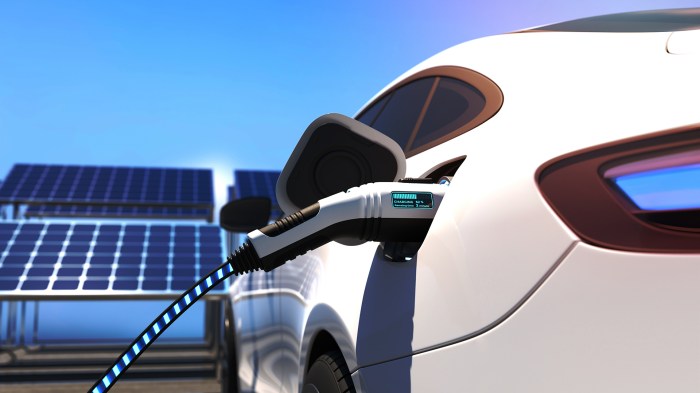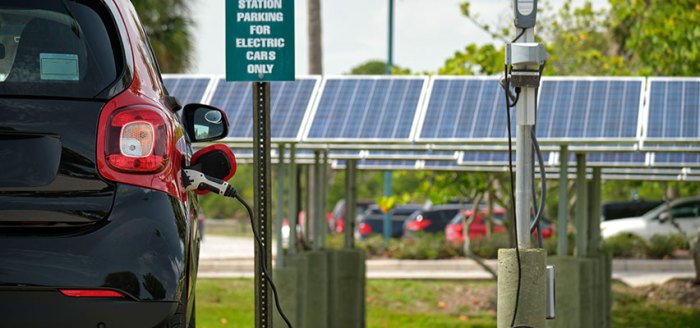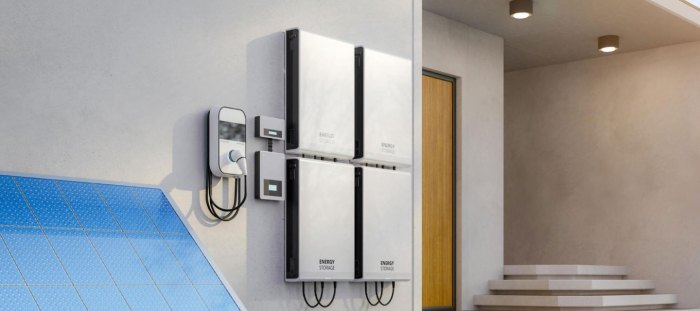Solar-powered EV charging at home 2025: It’s the future, right? Imagine this: you wake up, your car’s fully charged, and you’ve done it all with sunshine. No more range anxiety, no more guilt about your carbon footprint. But is it really as simple as plugging in to the sun? This deep dive explores the realities of powering your electric vehicle with home solar in 2025, looking at everything from panel size to smart home integration.
We’ll unpack the different types of chargers, the pros and cons of various battery storage solutions, and even the nitty-gritty of installation costs and potential government incentives. We’ll cut through the jargon and give you the straight dope on whether solar-powered EV charging at home is a realistic and worthwhile investment for you.
Home Solar Panel System Suitability for EV Charging in 2025

Going solar to power your electric vehicle (EV) at home is becoming increasingly popular, and 2025 will likely see even greater adoption. This means understanding how to size a home solar system to meet your EV charging needs is crucial. This section will explore the factors that influence solar panel system selection for home EV charging.
Typical Home Solar Panel System Size and Power Output for EV Charging
A typical home solar panel system suitable for powering an EV charger in 2025 might range from 5 to 15 kilowatts (kW) depending on several factors. A smaller system, say 5 kW, might suffice for someone with a smaller EV and limited daily driving, while a larger system, perhaps 10-15 kW, would be more appropriate for someone with a larger EV battery and a longer daily commute.
These systems would typically consist of multiple individual solar panels, each with a power output of around 300-400 watts. The total power output is determined by the number and type of panels installed. For example, a 10kW system might use 25-30 panels, depending on their individual wattage.
Factors Influencing Solar Panel System Size Selection for EV Charging
Several factors play a crucial role in determining the appropriate size of a home solar panel system for EV charging. These include the battery capacity of the EV itself, daily driving habits, and overall household energy consumption. A larger EV battery naturally requires more energy to charge fully, demanding a larger solar array. Similarly, someone who drives significantly more each day will need a larger system to replenish the energy used.
Finally, the total energy consumption of the household also needs to be considered; a home with high energy usage might require a larger system to cover both household needs and EV charging. Consider a family with two EVs, a large house, and significant energy use: they’ll need a significantly larger solar system than a single-person household with a smaller EV and low energy consumption.
Comparison of Solar Panel Technologies for Home EV Charging
Different solar panel technologies offer varying levels of efficiency, cost, and lifespan. Choosing the right technology is essential for maximizing return on investment and ensuring long-term reliability. The three main technologies are monocrystalline, polycrystalline, and thin-film.
So, solar-powered EV charging at home in 2025? Totally doable, and way cooler than relying on the grid. But maximizing your range is key, which is why understanding advancements like those discussed in this article on AI-driven range optimization in electric cars is super important. This tech will help you get the most out of your solar-charged drives, making home charging even more efficient and sustainable.
| Technology | Efficiency | Cost | Lifespan |
|---|---|---|---|
| Monocrystalline | 18-22% | Higher | 25-30 years |
| Polycrystalline | 15-17% | Lower | 20-25 years |
| Thin-Film | 8-13% | Lower | 15-20 years |
Note: These values represent general ranges and can vary depending on the specific manufacturer and model. Efficiency refers to the percentage of sunlight converted into electricity. Cost is a relative comparison, with monocrystalline generally being the most expensive and thin-film the least. Lifespan represents the expected operational life before significant performance degradation.
Types of EV Chargers Compatible with Home Solar Power

So you’ve got solar panels and an EV – awesome! But choosing the right charger is key to maximizing your solar-powered driving experience. This section breaks down the different types of EV chargers and how they work with your home solar setup, focusing on speed, power needs, and the pros and cons of each.
Essentially, EV chargers are categorized by the speed at which they charge your vehicle’s battery. This speed is directly related to the power they deliver, and consequently, how much energy they draw from your solar system (or the grid). Matching your charger type to your solar panel capacity is crucial for efficient and effective charging.
Level 1 Charging
Level 1 chargers are the simplest type. They use a standard 120-volt household outlet, the same one you use for lamps and appliances. This means they’re readily accessible and require no special installation. However, their charging speed is significantly slower than other options.
- Charging Speed: Very slow, adding only a few miles of range per hour. Expect a full charge to take many hours, potentially overnight.
- Power Requirements: 1.4 kW (kilowatts).
- Benefits: Low cost, readily available, requires no special installation.
- Drawbacks: Extremely slow charging time, not ideal for daily commutes or frequent driving.
Level 2 Charging
Level 2 chargers are the workhorse of home EV charging. They use a dedicated 240-volt circuit, the same as your clothes dryer or oven, and deliver significantly faster charging speeds. This is the most popular choice for home solar integration.
- Charging Speed: Substantially faster than Level 1, typically adding 25-40 miles of range per hour. A full charge can take several hours, depending on the vehicle and charger’s power output.
- Power Requirements: Typically 3.6 kW to 19.2 kW, but higher power options exist.
- Benefits: Significantly faster charging than Level 1, a good balance between speed and cost, suitable for most home solar setups.
- Drawbacks: Requires professional installation of a dedicated 240-volt circuit, higher initial cost than Level 1.
DC Fast Charging
DC fast chargers are the speed demons of the EV charging world. They deliver high-voltage direct current (DC) electricity directly to the vehicle’s battery, resulting in incredibly fast charging times. However, they are not typically suitable for home use due to their high power demands and significant installation costs.
- Charging Speed: Extremely fast, capable of adding hundreds of miles of range in under an hour.
- Power Requirements: Ranges from 50 kW to 350 kW or more. This requires a massive power supply and specialized equipment, far exceeding what a typical home solar system can provide.
- Benefits: Incredibly fast charging.
- Drawbacks: Extremely high cost, requires specialized and complex installation, unsuitable for most home solar setups, potential strain on the electrical grid.
Energy Storage Solutions for Home Solar EV Charging
Integrating energy storage with your home solar setup significantly enhances the reliability and efficiency of EV charging. Without storage, your EV charging relies entirely on the immediate solar power generation, meaning charging may be interrupted or slow during periods of low sunlight, like cloudy days or evenings. Energy storage systems act as a buffer, storing excess solar energy for use later, ensuring consistent and optimized charging regardless of weather conditions.
Several home energy storage solutions are available to meet diverse needs and budgets. These solutions range from smaller battery banks suitable for supplementing solar power to larger, more sophisticated systems capable of powering an entire home for extended periods.
Home Battery Systems and Power Walls
Home battery systems, often marketed as “power walls,” are the most common energy storage solution for residential solar setups. These systems typically consist of a collection of lithium-ion batteries housed in a compact unit, often designed for easy installation and integration with existing solar inverters and EV chargers. They allow you to store excess solar energy generated during the day and use it to charge your EV at night or during periods of low solar irradiance.
Tesla’s Powerwall is a well-known example, but numerous other manufacturers offer comparable systems with varying capacities and features. For instance, a homeowner in California with a 5kW solar panel system might use a 10kWh Powerwall to store enough energy to fully charge their EV overnight even on a cloudy day. The system’s capacity should be chosen based on the homeowner’s energy consumption and desired level of energy independence.
Thinking about solar-powered EV charging at home in 2025? It’s a pretty sweet setup, but don’t forget to check out the fine print on Federal EV tax credit eligibility 2025 to see if you qualify for some serious savings. Knowing the tax credit rules can help you maximize your green energy investment and make that solar-powered charging even more affordable.
Benefits of Energy Storage for Consistent EV Charging
The primary benefit of using energy storage for EV charging is the guarantee of consistent charging, regardless of solar output. This eliminates the reliance on grid power, reducing electricity bills and carbon footprint. Furthermore, energy storage optimizes the use of self-generated solar energy, maximizing the return on investment in the solar panel system. In scenarios of grid outages, a home battery system can provide backup power for the EV charger, ensuring mobility even during power disruptions.
This enhanced energy independence is a key selling point for many homeowners considering this technology.
Comparison of Battery Chemistries
Choosing the right battery chemistry is crucial for long-term performance and cost-effectiveness. Several chemistries are available, each with its own advantages and disadvantages.
| Chemistry | Lifespan (Cycles) | Cost per kWh (USD) | Environmental Impact |
|---|---|---|---|
| Lithium-ion | 5,000-10,000+ | $300-$600 | Moderate (mining and manufacturing impact, but recyclable) |
| Lead-acid | 500-1000 | $100-$200 | High (lead toxicity, limited recyclability) |
While lead-acid batteries are significantly cheaper upfront, their shorter lifespan and higher environmental impact make lithium-ion batteries the preferred choice for most home energy storage applications. The higher initial cost of lithium-ion is offset by their longer lifespan and reduced environmental concerns.
Installation and Cost Considerations for Home Solar EV Charging Systems in 2025

Going solar for your EV charging needs in 2025 is a big step, but understanding the installation process and associated costs will make the transition smoother. This section breaks down the key aspects to consider, from permits to potential savings.
Permitting and Site Assessment
Securing the necessary permits is the first hurdle. This involves contacting your local building department and utility company to determine the requirements for installing solar panels and an EV charger. A site assessment by a qualified solar installer is crucial. This assessment evaluates your roof’s suitability, shading conditions, and energy consumption patterns to determine the optimal system size and placement.
The assessment typically includes a detailed report outlining the proposed system design, equipment specifications, and estimated energy production. Permitting timelines vary by location, but expect delays of several weeks to a few months.
Equipment Selection and System Design
Choosing the right equipment is key to a successful installation. This includes selecting solar panels, an inverter, an EV charger, and potentially a battery storage system. Solar panel selection depends on factors like efficiency, wattage, and aesthetics. Inverter selection is crucial as it converts DC power from the panels to AC power for your home and EV charger.
EV chargers range from Level 1 (standard household outlet) to Level 2 (dedicated circuit) and DC fast chargers (requiring specialized equipment and higher installation costs). Battery storage systems provide backup power and can optimize energy usage by storing excess solar energy for later use. The installer will design a system tailored to your specific needs and energy consumption.
Professional Installation Process
Professional installation is strongly recommended. This involves a team of qualified electricians and solar installers who handle all aspects of the installation, from panel mounting and wiring to inverter connection and charger setup. The process typically begins with the installation of the solar panels on your roof, followed by the installation of the inverter and the EV charger.
This often includes running new wiring and connecting the system to your electrical panel. A final inspection by the local authorities is required to ensure compliance with building codes and safety regulations before the system can be fully commissioned.
Cost Breakdown of Home Solar EV Charging Systems
The cost of a home solar EV charging system varies significantly depending on several factors, including system size, equipment choices, and installation complexity. However, we can provide a general cost breakdown based on average values in 2025 (all figures are approximate and may vary regionally):
| Component | Estimated Cost (USD) |
|---|---|
| Solar Panels (6kW system) | $12,000 – $18,000 |
| Inverter | $2,000 – $4,000 |
| Level 2 EV Charger | $500 – $1,500 |
| Battery Storage (optional, 10kWh) | $10,000 – $15,000 |
| Installation Labor | $5,000 – $10,000 |
| Permitting and Inspections | $500 – $1,500 |
Note that these are estimates, and the actual cost may vary significantly depending on the specific components chosen, the complexity of the installation, and location-specific factors.
Government Incentives and Rebates
Several government incentives and rebates can significantly reduce the upfront cost of a home solar EV charging system. These incentives vary by state and local jurisdictions, but common programs include tax credits for solar panel installations, rebates for EV charger purchases, and potential net metering credits for excess solar energy fed back to the grid. For example, the federal Investment Tax Credit (ITC) in the United States provides a tax credit for a percentage of the cost of solar panel installations.
It’s crucial to research the available incentives in your specific area before proceeding with an installation to maximize your savings. Contact your local utility company and state energy office for information on applicable programs.
Smart Home Integration and Energy Management for Solar EV Charging: Solar-powered EV Charging At Home 2025
Smart home technology is rapidly transforming how we manage energy consumption, and its integration with solar-powered EV charging is a game-changer. By intelligently coordinating solar energy generation, battery storage, and EV charging demands, homeowners can maximize self-consumption of renewable energy, minimize reliance on the grid, and potentially save money on electricity bills. This integration offers a more sustainable and cost-effective approach to electric vehicle ownership.Smart home systems leverage sophisticated algorithms and real-time data to optimize energy flow within the household.
This optimization includes prioritizing the use of solar energy for EV charging when it’s abundant, shifting charging to off-peak hours when electricity prices are lower, and intelligently managing energy storage to ensure a consistent power supply. The ability to predict and adapt to changing energy demands and solar generation patterns makes this a dynamic and efficient system.
Smart EV Charger Features
Smart EV chargers offer a range of features designed to enhance energy management. These features go beyond simply plugging in your car; they allow for precise control over charging schedules, power draw, and energy monitoring. This level of control allows for seamless integration with the broader smart home ecosystem. For example, a homeowner could schedule charging to begin only when solar production is high, ensuring that the car is charged using clean, renewable energy.
They could also set limits on the charging rate to avoid overloading the home’s electrical system.
Home Energy Management System Diagram, Solar-powered EV charging at home 2025
Imagine a diagram depicting a simplified smart home energy system. The diagram would show three main components: solar panels on the roof, a home energy storage system (HESS) like a Tesla Powerwall, and a smart EV charger in the garage. Arrows would illustrate the flow of energy.First, sunlight strikes the solar panels, generating DC electricity. This DC electricity flows to a solar inverter, which converts it to AC electricity suitable for household use.
A portion of this AC electricity is directly used to power the home and charge the EV through the smart EV charger. Simultaneously, excess solar energy is diverted to the HESS for storage. The HESS acts as a buffer, storing energy during peak solar production and releasing it when solar generation is low or when the demand for electricity is high, such as during the evening when the EV is charging.
The smart home system monitors the energy levels in the solar panels, the HESS, and the EV battery, constantly adjusting the power flow to optimize energy use and minimize reliance on the grid. The smart EV charger communicates with the smart home system to receive instructions on when and at what rate to charge the EV, ensuring that the charging process is aligned with the overall energy management strategy.
The system also provides real-time energy monitoring and reporting capabilities, allowing homeowners to track their solar energy production, consumption, and energy storage levels. This information empowers homeowners to make informed decisions about their energy usage and optimize their energy consumption habits.
Environmental Impact and Sustainability of Home Solar EV Charging
Pairing home solar power with electric vehicle (EV) charging offers a compelling path towards a greener transportation future. By generating clean energy on-site, this approach significantly reduces reliance on fossil fuel-based electricity generation, leading to substantial environmental benefits compared to charging from the traditional power grid.The environmental advantages stem from the inherent nature of solar energy. Unlike coal or natural gas power plants, solar panels produce electricity without directly emitting greenhouse gases or air pollutants during operation.
This directly translates to a lower carbon footprint for your EV’s charging process. Moreover, the reduced demand on the grid minimizes the need for additional fossil fuel-based power generation, contributing to broader environmental improvements beyond your individual household.
Carbon Footprint Reduction from Solar-Powered EV Charging
The amount of carbon emissions avoided through solar EV charging varies depending on several factors, including the geographical location (solar irradiance), the size of the solar panel array, the electricity consumption patterns of the household, and the grid’s carbon intensity. However, significant reductions are consistently observed. For example, studies have shown that charging an EV with solar power can reduce its carbon footprint by 50-80% compared to grid electricity, particularly in regions with high solar resource availability and grids heavily reliant on fossil fuels.
This translates to a considerable decrease in greenhouse gas emissions and improved air quality. Consider a household that consumes 5000 kWh annually for EV charging. If their grid electricity is 50% carbon-based, they’d be emitting 2500 kWh worth of carbon emissions. Switching to a solar-powered system could reduce this by 50-80%, potentially saving 1250-2000 kWh of carbon emissions annually.
Examples of Successful Home Solar EV Charging Implementations
Numerous successful implementations demonstrate the environmental benefits of home solar EV charging. Consider a community in California where many residents have installed rooftop solar panels coupled with EV chargers. Their combined efforts have demonstrably reduced the community’s overall carbon footprint, as evidenced by decreased grid demand and associated fossil fuel consumption. Similarly, several university campuses are adopting this approach to power their electric vehicle fleets, showcasing its practicality and scalability on a larger scale.
These initiatives provide real-world evidence of the environmental sustainability achievable through the integration of home solar and EV charging. Furthermore, data collected from smart meters and energy management systems within these implementations provide quantifiable evidence of the reduction in carbon emissions and the improvement in energy efficiency.
Final Thoughts
So, is home solar EV charging in 2025 a game-changer? Absolutely. While there are definitely factors to consider—like your energy consumption, available sunlight, and upfront costs—the potential benefits are huge. From environmental responsibility to long-term cost savings, going solar for your EV could be one of the smartest moves you make. Do your research, weigh your options, and get ready to drive into a cleaner, greener future, one sunny day at a time.









